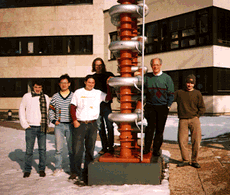
The ALEPH group at SCIPP posing by a High Voltage Generator


The ALEPH group at SCIPP posing by a High Voltage Generator |
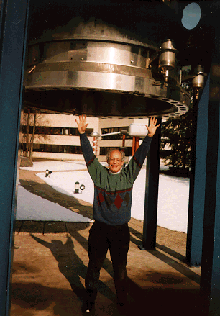 Project Leader: |
Alan Litke's research interests are primarily in the
field of experimental particle physics. The goal of
this research is to better understand the constituents
and forces in nature, and to try to discover new and
fundamental facts about the world. He has participated
in experiments in which a new quark (charm), a new lepton
(tau), and new atomic-like systems of a quark and
anti-quark (psi' and psi''), have been discovered. His
group developed and implemented (with collaborators) the
first high-precision silicon vertex detector for colliding
beam experiments, based on the technology of integrated
circuits. This type of device is now widely used for the
study of the tau lepton and the beauty
and top quarks. Litke's present research is on the ALEPH experiment at the LEP electron-positron collider, located at the CERN laboratory in Geneva. One goal of this experiment is to study the properties of the Z0, one of the gauge bosons responsible for the weak force. A second goal, which Litke's group is very actively involved in, is the study of the states of beauty, in which ALEPH's silicon vertex detector plays a critical role. This research is laying some of the groundwork for future studies, in the beauty system, of the subtle imperfection in the symmetry between matter and anti-matter ("CP violation"). Over the next few years, LEP's energy will be more than doubled, opening a new energy domain for exploration. Litke's group will be searching for new physics, including the "Holy Grail" of particle physics, the Higgs boson. The increase in energy will also allow ALEPH to study the properties of the charged gauge bosons, the W+ and W-. In addition to his work in particle physics, Litke has an interest in neurophysiology. He has collaborated with neurophysiologists at Standford, applying integrated circuit fabrication techniques to make " retinal readout arrays". These electrode arrays are being used to detect signals from the individual output neurons of live retinal tissue, and thereby study information processing in the retina. In his time away from the lab, Litke likes to hike and ski with his wife and three children. He is also trying to learn to play tennis and speak french. How to contact Alan
LITKE@CERNVM.CERN.CH |

|
|
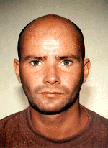 Postdoc: |
Gary Taylor was born in Irvine, Scotland. He got his degree in Physics from
Glasgow university. He went on the study for a doctorate in experimental
particle physics at Imperial College (London). His thesis was based on data
taken at LEP by the ALEPH experiment and was entitled
"Beauty production in hadronic Z decays."
In 1992 he joined the UC Santa Cruz group as a Postdoc to continue his research
on the ALEPH experiment. Gary's physics interests during his time at Santa Cruz
have concentrated on B hadron spectroscopy and searches for rare B decays.
These studies were made possible by the installation into ALEPH in 1991
of a double sided silicon vertex detector. Gary played a major role
in the comissioning of this detector as a high precision physics tool.
This included work on the alignment and calibration of the device but
concentrated on implementing a greatlt improved treatment of the effects
of multiple scattering in the vertex detector region.
By exploiting the capabilities of the vertex detector Gary was able to
observe a
few golden events
attributed to the presence of a meson containing a b
quark and a strange anti-quark, the BsubS.
Gary used these events to obtain a measuremnet of the BsubS mass.
Gary has also made a search for charmless hadronic b decays. He observed 4
candidate events with a statistical significance of almost 5 sigma.
More recently, Gary has looked at multiphoton the LEP 1.5 data taken at around 136 GeV for
anomolous photon production.
Descrepancies in the production of high energy photons at this energy
would be a sign of inconsistencies in the well established theory of QED
(Quantum Electrodynamics). In particular, it could show signs for
compositeness in electrons (i.e. the point-like electrons of QED might
have some internal structure).
Gary lives in Ferney-Voltaire. He particularly enjoys skiing, golf and scuba-diving.
He has been known to wear a kilt on special occasions.
How to contact Gary
TAYLORG@ALOHA.CERN.CH |

|
|
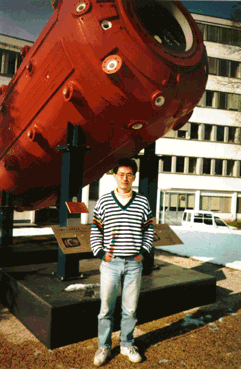 Postdoc: |
Hwi Kim was born in Seoul Korea and came to U.S. with his immigrating family
in 1976. He attended the University of Washington for his undergraduate work
where he got a bachelors of science in physics. He then continued his
graduate work in the same University and joined the SLD experiment at SLAC
in 1987. At SLAC, he developed various softwares for simulation and
reconstruction of calrorimeters, and designed an offline Z0 filter which
was responsible for identifying the first Z0's recorded with the SLD detector
and remained the standard. In 1991, he joined the ALEPH experiment at CERN,
and worked on the R&D of straw chamber and ALEPH's Beam Orbit Monitor(BOM).
He wrote his PhD thesis on the Tau Lepton lifetime using a new method for
calculating this lifetime called the MIPS (Momentum dependent Impact
Parameter
Sum) method. He was awarded the Henderson Prize for excellence in thesis
research from the University in 1995.
UC Santa Cruz hired Hwi in 1993 to work at the ALEPH experiment.
He has continued his interest in Tau physics at ALEPH. Combining his
MIPS method with other lifetime measureing methods to come up with
what will be the most accurate measurement of the Tau lifetime which is
essential in testing the lepton universality. Hwi is also involved in
offline software for the new Vertex Detector installed in October of 1995,
the ARBLIS radiation protection project, searches for new particles.
Hwi lives near Gex with his wife, Julie. They are excitedly expecting a
first child in June 1996.
How to contact Hwi
HWIKIM@CERNVM.CERN.CH |

|
|
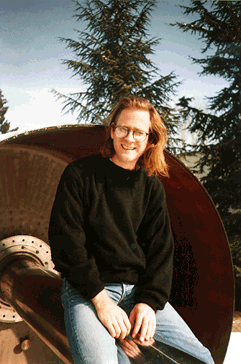 Graduate Student: |
Michael was born in Sacremento, California (?). He obtained his Bachelors
degree in Physics from UC Berkeley and moved on to UC Santa Cruz to work on
his doctorate. Michael's major focus is on b quark physics. He has done a
search for a bottom and charm quark meson, the Bc, and although he
didn't have a statistically significant signal, he found some !interesting
events!. Currently Michael is devising an analysis to use the an excited
state of the B meson, the B**, to make of measurement of CP violation.
This method of measuring on off the fundamental mysteries of maodern particle
physics has just been developed and could be the best way to measure CP
violation at the Large Hadron Collider (LHC) when it goes online in the year
200?. Michael also has contributed heavily to the running of the ALEPH
experiment, coordinating the ARBLIS radiation protection system and being
in charge of the quality of offline data the for the VDET. Michael currently
lives with his girlfriend, Astrid, in Lausanne. However, he plans to move
back to the bay area once his thesis analysis is completed. Michael in
musically inclined, playing the piano and guitar, and especially likes
Latin jazz. Here's an excerpt from one of our favs..
Long, and Tan, and Young, and Lovely, How to contact Michael
MCNEIL@AXAL05.CERN.CH |

|
|
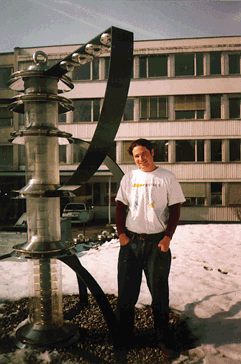 Graduate Student: |
James was born and raised in San Francisco, and
thus, is a
wretched 49'ers fan. James received his Bachelors degree in physics
from UC Santa Barbara. Currently he is a 4th year graduate student at
UC Santa Cruz and working on his PhD thesis. James is specializing in
particle physics where his work has taken him to the exciting
international laboratory, CERN, stationed in Geneva, Switzerland. James
(along with Robert Johnson and Simon Black) completed a study of the
inlusive production rates of the strange baryons in Z decays. Their
paper was submitted to the Brussels Conference, summer '95; soon it will
be submitted to physics letters for official publication. He has taken
over as the ARBLIS coordinator for Aleph and
recently installed an upgraded ARBLIS ring for the new Vertex Detector.
Currently as LEP energies have soared to new heights for an e+ e-
machine so has James' interests. That is,
he is currently doing an analysis to study nphoton final states in the
hope of making a discovery. This, most likely, will be his doctorate
thesis topic.
James lives in Geneva with his fiancee, Gabriella. He is studying
French and enjoys playing basketball, skiing, biking and traveling in Europe.
How to contact James
DANNJ@ALOHA.CERN.CH |

|
|
 Graduate Student |
Simon was born in Laguna Beach and grew up in Santa Monica,
California. He
got his Bachelors Degree of Science in Physics from UCLA. Particle Physics was
Simon's focus even as an undergraduate. The undergraduate particle physics
laboratory
had some very old Drift Chambers that Simon spent hours trying to make work,
in order to measure Multiple Coulomb Scattering. He wrote a senior
thesis at UCLA titled "The Search for Supersymmetric Particles by CDF at
Fermilab". He also was fortunate
enough to get a three month position working as an Undergraduate Research
Assistant
at Brookhaven
Laboratory in New York. There, he worked on an experiment searching for a
single particle with 6 quarks called the H-dibaryon. Unfortunately, the
search was unsuccessful. Simon then moved on to Santa Cruz for his graduate
work. There he became involved with the ALEPH experiment, where James, Robert
and he measured the production rates of Strange Baryons at the Z0 peak. This
report was received by the Brussels 1995 summer conference. Currently
Simon is working on the new Vertex Detector, writing online and offline
analysis software. He also has become fascinated with World Wide Web and
it's infinite future possibilities. See his
home page.
Simon currently lives in Geneva with his girlfriend Rachel, but will be
moving back to Santa Cruz in April 1996. In his spare time, Simon likes
basketball, hiking,
computer games, reading sci-fi fantasy, Star Trek (his real inspiration to be
a physicist is to invent the warp drive engine) and traveling.
How to contact Simon
BLACK@ALOHA.CERN.CH |